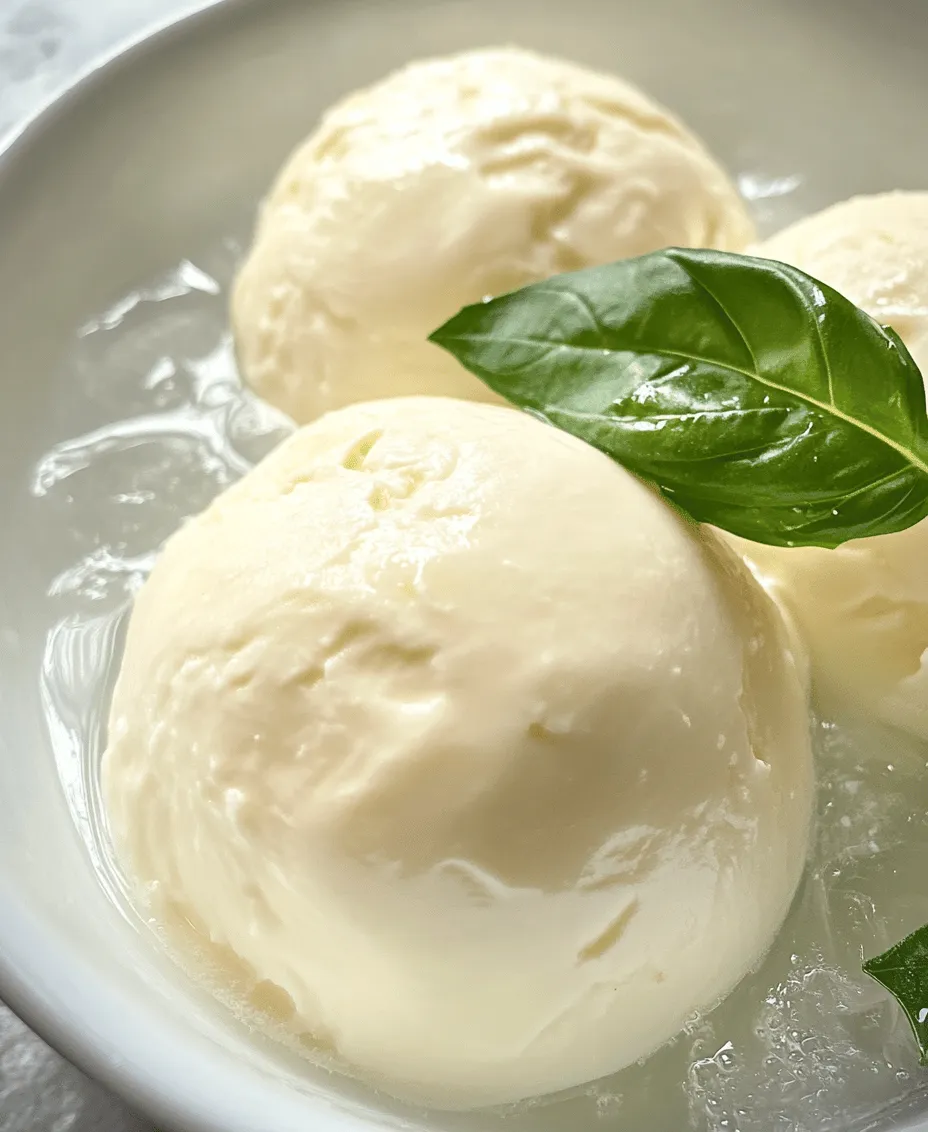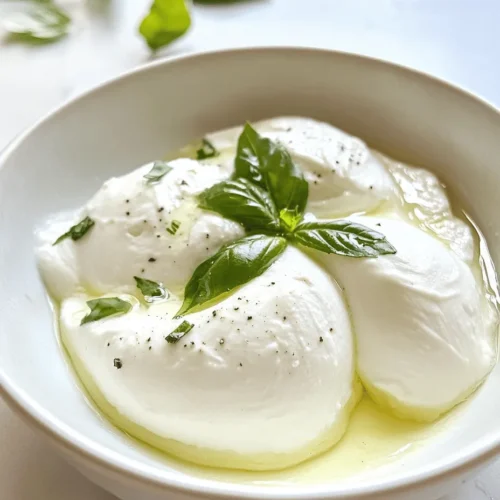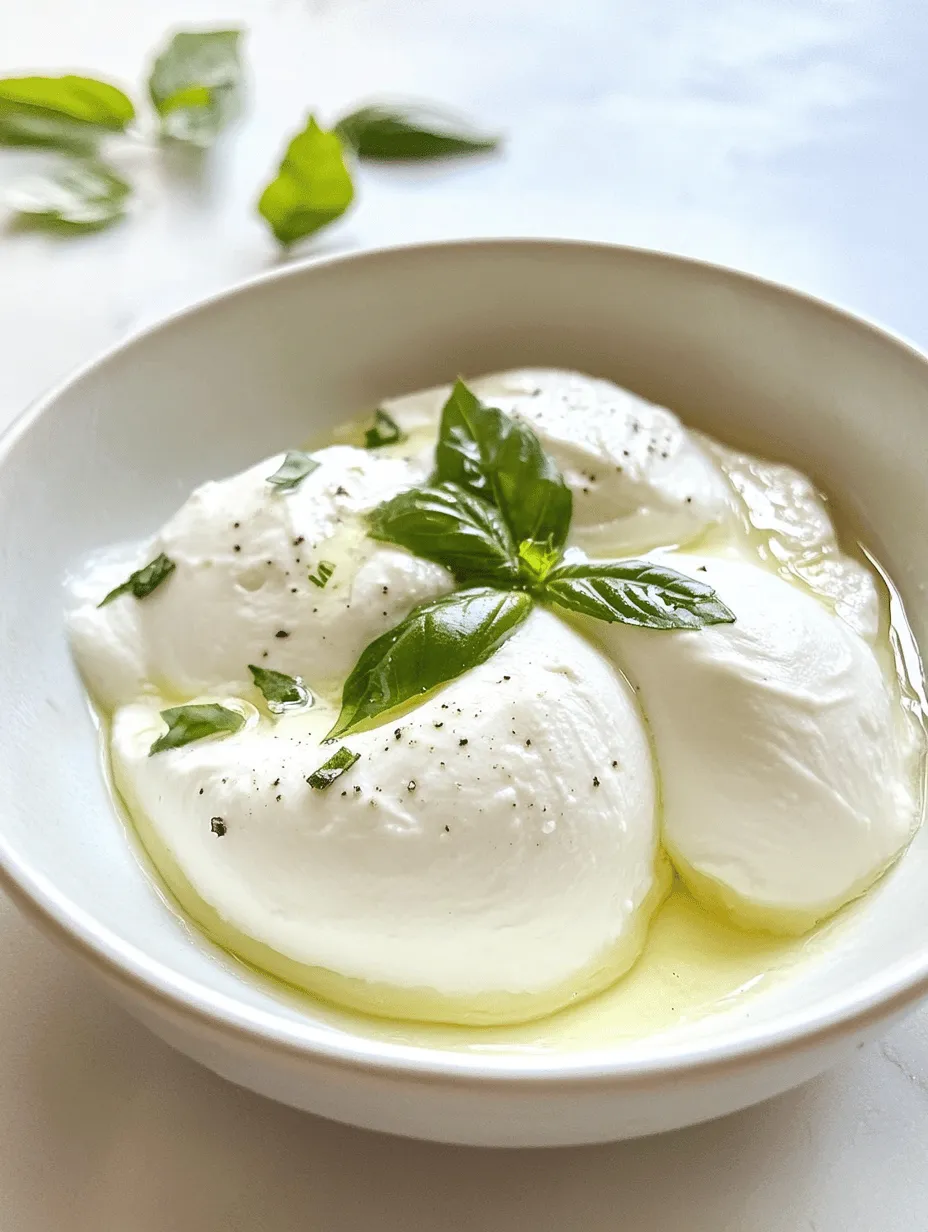Introduction
Mozzarella cheese, with its creamy texture and delightful stretch, is a staple in kitchens around the world. Originating from Italy, this beloved cheese is not only prized for its mild flavor but also for its versatility in a myriad of dishes including pizzas, salads, and pasta. The culinary significance of mozzarella extends beyond its use; it symbolizes the art of cheesemaking and the joy of creating something from scratch. As the world of gastronomy continues to evolve, more home cooks are discovering the satisfaction that comes from making cheese at home.
Creating your own mozzarella cheese allows you to experience unparalleled freshness and flavor. Unlike store-bought varieties, homemade mozzarella offers a unique taste profile, as you have complete control over the ingredients and processes involved. Whether you are an experienced cook or a curious novice, this recipe for creamy homemade mozzarella cheese will guide you through the process of transforming simple ingredients into a deliciously creamy cheese that will elevate your culinary creations. With just a few essential ingredients and some basic equipment, you can enjoy the rewarding outcome of fresh mozzarella right in your own kitchen.
Understanding the Ingredients
To embark on your mozzarella-making journey, it’s essential to understand the key ingredients that will come together to create this delightful cheese. Each component plays a crucial role in the cheesemaking process, contributing to the flavor, texture, and overall outcome of your mozzarella.
Whole Milk
The foundation of any good mozzarella cheese is high-quality whole milk. When selecting milk, it is recommended to use raw or non-homogenized varieties, as they contain the natural cream that is ideal for cheesemaking. Raw milk, in particular, offers a richer flavor and creamier texture, making it a favorite among artisanal cheesemakers. If raw milk is not available, look for whole milk from a local dairy that is free from additives and preservatives. The quality of your milk will directly impact the flavor and texture of your mozzarella, so choose wisely!
Rennet
Rennet is a crucial ingredient in the cheesemaking process, acting as a coagulant that helps to separate the curds from the whey. It is an enzyme traditionally derived from the stomachs of ruminant animals, but there are also vegetarian alternatives available, such as microbial rennet or vegetable rennet made from specific plants. For those who prefer not to use animal-derived rennet, these alternatives work just as effectively in curdling the milk. When purchasing rennet, ensure you follow the instructions carefully, as the amount needed can vary based on the milk’s volume and type.
White Vinegar
White vinegar plays a vital role in the curdling process by providing the acidity needed to help separate the curds and whey. It enhances not only the curdling process but also contributes a subtle tang to the flavor of the mozzarella. If you prefer, you can also use lemon juice as a natural alternative to vinegar, imparting a fresh citrus note to the cheese. The addition of acid is essential for achieving the desired consistency and flavor profile in your mozzarella.
Salt
Salt is a critical ingredient in cheesemaking, serving multiple purposes. It enhances the flavor of the mozzarella, balances the acidity, and helps to inhibit unwanted bacterial growth during the aging process. Adding salt to your mozzarella is not only about seasoning; it also plays a role in the overall texture and longevity of the cheese. When making mozzarella, salt can be added to the curds before shaping or sprinkled on the finished cheese for a flavor boost. Experimenting with different types of salt, such as sea salt or kosher salt, can also yield interesting results.
Optional Flavorings
While classic mozzarella is delightful on its own, you can explore various flavorings to customize your cheese. Fresh herbs such as basil, oregano, or thyme can be mixed into the curds for a fragrant and flavorful twist. Additionally, spices like garlic powder or crushed red pepper flakes can add a zesty kick. The beauty of homemade mozzarella is that you can tailor it to your taste preferences, making it a versatile addition to your culinary repertoire.
Essential Equipment for Cheese Making
Before diving into the process of making mozzarella, it’s important to gather the necessary tools and equipment. Having the right items on hand will ensure a smooth and successful cheesemaking experience.
Large Pot for Heating Milk
A heavy-bottomed large pot is essential for heating the milk evenly and preventing scorching. Choose a pot that is large enough to hold the volume of milk you intend to use, allowing sufficient space for the milk to expand as it heats. Stainless steel or enameled cast iron pots are ideal choices for this task.
Thermometer for Accurate Temperature Measurement
Precision is key in cheesemaking, especially when it comes to temperature control. A reliable thermometer will help you monitor the milk’s temperature throughout the process. An instant-read thermometer or a digital probe thermometer are both excellent options that provide accurate and quick readings.
Colander and Cheesecloth for Separating Curds and Whey
Once the milk has been curdled, you’ll need a colander to drain the whey from the curds. Line the colander with cheesecloth, which will catch the curds while allowing the whey to drain away. Cheesecloth is a lightweight, breathable fabric that is perfect for this purpose, ensuring that your homemade mozzarella retains its desired texture.
Microwave-Safe Bowl for Melting Curds
After the curds have formed and been drained, they will need to be melted to achieve that signature stretchiness. A microwave-safe bowl is ideal for this step, as it allows you to melt the curds quickly and efficiently. If you prefer not to use a microwave, you can also melt the curds in a warm water bath.
Ice Bath for Cooling the Cheese
Once your mozzarella has been formed, it’s important to cool it down quickly to preserve its texture and freshness. Prepare a bowl or sink filled with ice water, which will act as an ice bath for the cheese. This step ensures that your mozzarella remains creamy and maintains its beautiful shape.
Step-by-Step Instructions for Making Mozzarella
Now that you have a solid understanding of the ingredients and equipment needed, it’s time to dive into the step-by-step process of making creamy homemade mozzarella cheese. Each step is designed to guide you through the cheesemaking journey, ensuring that you achieve the best possible results.
1. Prepare the Milk: Begin by pouring your whole milk into the large pot. If you are using raw milk, it is wise to gently heat it to a temperature of 30°C (86°F) to ensure that any unwanted bacteria are eliminated while preserving the milk’s natural flavor.
2. Add Rennet: Once the milk has reached the desired temperature, stir in the rennet according to the package instructions. It’s important to mix it thoroughly but gently, as you want to avoid creating too many bubbles. Allow the milk to sit undisturbed for 5-10 minutes, during which time it will begin to coagulate.
3. Cut the Curd: After the curd has formed, use a long knife to cut it into small cubes, about 1-inch in size. Allow the curds to rest for another 5 minutes, which will help them release more whey.
4. Heat the Curds: Slowly heat the curds over low heat, stirring gently to prevent them from sticking together. Increase the temperature to about 40°C (104°F) and maintain this temperature for approximately 5-10 minutes. This step helps the curds firm up and further expel whey.
5. Drain the Curds: Once the curds have reached the desired firmness, carefully pour them into the colander lined with cheesecloth. Allow the whey to drain for about 5-10 minutes, but don’t let the curds sit too long, as they can become too dry.
6. Melt the Curds: Transfer the drained curds into the microwave-safe bowl. Microwave the curds in 30-second intervals, kneading them gently between intervals, until they are hot and pliable. You can also melt the curds in the warm water bath if you prefer a gentler method.
7. Knead and Shape: Once the curds are melty and stretchy, sprinkle in the desired amount of salt and any optional flavorings. Knead the curds until they become smooth and shiny, then shape them into balls or logs, depending on your preference.
8. Cool the Mozzarella: Immediately immerse your shaped mozzarella into the ice bath to cool it down quickly. This will help maintain its texture and flavor.
With these initial steps complete, you’re well on your way to enjoying your very own creamy homemade mozzarella cheese. The process may seem daunting at first, but with practice, you’ll find it to be a rewarding and enjoyable culinary adventure. As you continue to explore cheesemaking, remember that the joy of crafting your own cheese lies not only in the delicious outcome but also in the journey of creating something truly special in your kitchen. Stay tuned for the next part, where we will delve deeper into the nuances of mozzarella making and share tips for achieving the perfect cheese every time.

Warming the Milk: Techniques for Achieving the Perfect Temperature
To create the perfect creamy mozzarella cheese, the first step involves warming the milk to the right temperature. This crucial phase can make a significant difference in the texture and overall quality of your cheese. The ideal temperature for warming milk is around 190°F (88°C). At this temperature, the proteins in the milk will start to denature, which is essential for the curdling process.
For optimal results, use a heavy-bottomed pot to distribute heat evenly and prevent scorching. Heat the milk slowly over medium-low heat while stirring gently to avoid sticking to the bottom. A reliable kitchen thermometer is essential here; it ensures you don’t miss the critical temperature window. If you’re using raw milk, be sure to pasteurize it first by heating it to at least 165°F (74°C) for 15 seconds before bringing it to the curdling temperature.
Adding Vinegar: How to Recognize the Curdling Process
Once the milk has reached the desired temperature, it’s time to add vinegar, which is a key ingredient that helps in curdling the milk. Use white vinegar or apple cider vinegar for this process. Start by slowly pouring in about 1/4 cup of vinegar while gently stirring the milk.
You will notice the milk beginning to curdle almost immediately. The curdling process is characterized by the formation of small white curds separating from the liquid whey. Within a few minutes, you should see distinct lumps forming. If the curds are not forming properly, you can add a little more vinegar, but be cautious not to add too much, as this can result in overly tangy cheese.
Separating Curds and Whey: Detailed Explanation of the Process and Tips for Success
Once the curds have formed and the whey has separated, it’s time to separate the two. Using a slotted spoon or a fine-mesh strainer, carefully ladle the curds into a bowl, leaving the whey behind. Allow the curds to drain for about 5 to 10 minutes.
For best results, you can line the strainer with cheesecloth to catch smaller curds that might otherwise slip through. The key here is to be gentle; you want to preserve the integrity of the curds as much as possible. If you find that your curds are too dry, you might want to retain some of the whey to mix back in later, especially if you prefer a creamier texture for your mozzarella.
Rinsing Curds: Importance of Cooling and Removing Unwanted Flavors
After separating the curds, it’s essential to rinse them under cold water. This step serves two purposes: it cools the curds quickly, preventing further cooking, and it helps wash away any residual acidic flavors from the vinegar. Place the curds in a bowl and run cold water over them, gently stirring to ensure all curds are rinsed thoroughly.
This cooling process is crucial because it prepares the curds for the next steps, particularly the melting and stretching phases. The rinsing also helps achieve a fresher, cleaner flavor in your final cheese product. After rinsing, allow the curds to drain again in the strainer for a few minutes, ensuring excess moisture is removed to achieve the right consistency.
Melting Curds: Ensuring the Right Consistency for Stretching
With the curds rinsed and drained, it’s time to melt them for stretching. Transfer the curds to a microwave-safe bowl or a pot if you prefer the stovetop method. If using a microwave, heat the curds in 30-second intervals, gently kneading them with a spatula or your hands between intervals. You want the curds to reach a temperature of about 135°F (57°C) for optimal stretchiness.
If you’re using the stovetop, place the curds back over low heat and stir gently until they begin to melt. Be careful not to overheat, as this can lead to rubbery cheese. The goal is to achieve a pliable, smooth texture. If the curds seem too dry or crumbly, you can add a little reserved whey or warm water to help them incorporate better.
Incorporating Rennet: How and When to Add Rennet for Optimal Texture
Incorporating rennet into your cheese-making process is crucial for achieving that classic mozzarella texture. If you’re using liquid rennet, dilute it in a small amount of cool, non-chlorinated water. Once your curds have melted and reached the right consistency, this is the perfect time to add the rennet.
Stir the diluted rennet gently into the melted curds for about 30 seconds, ensuring it’s evenly distributed. Allow the curds to sit undisturbed for about 5 minutes. This resting period helps the curds to firm up and develop the desired elasticity crucial for stretching. If you prefer a more traditional method, you can also use rennet tablets—just follow the package instructions for proper dosages.
Stretching the Cheese: Techniques for Achieving the Perfect Elasticity
The heart of mozzarella-making lies in stretching the cheese. Once the curds have rested, it’s time to knead and stretch them. With clean, wet hands, begin to pull and fold the curds. If the curds are too cool and resist stretching, consider warming them slightly in the microwave or in hot water until they become pliable again.
For optimal texture, stretch the curds slowly and evenly. You can stretch them in your hands or use a rolling pin for larger batches. If done correctly, the cheese should become shiny and elastic, akin to taffy. The more you stretch, the smoother and more cohesive your mozzarella will become. Once you achieve the desired stretch, shape the cheese into balls or logs and place them into a bowl of cold water or an ice bath to set.
Shaping and Storing: Best Practices for Storing Mozzarella to Maintain Freshness
After stretching and shaping your mozzarella, it’s essential to store it properly to maintain its freshness. If you’ve shaped the cheese into balls, submerge them in a brine solution made of salt and water (around 1 tablespoon of salt per cup of water). This brine not only infuses flavor but also helps preserve the cheese.
If you prefer to store your mozzarella for longer periods, wrap it in plastic wrap and place it in an airtight container in the refrigerator. Homemade mozzarella is best consumed within a week for optimal flavor and texture, but it can last up to two weeks if stored correctly. Avoid freezing mozzarella, as it can change the texture and make it crumbly upon thawing.
Troubleshooting Common Issues
Curdling Problems: What to Do if the Milk Doesn’t Curdle Properly
If you find that your milk hasn’t curdled after adding vinegar or rennet, there are a few troubleshooting steps you can take. First, check the freshness of your milk and vinegar; expired products may not yield the desired results. If the milk is fresh and curdling still hasn’t occurred, try gently increasing the temperature a bit more. Sometimes, a little extra heat can kickstart the curdling process.
If problems persist, consider adding a bit more vinegar or rennet, but do so gradually to avoid overpowering flavors. Patience is key; sometimes, it takes a few extra minutes for the curds to form.
Texture Troubles: Solutions for If the Cheese Doesn’t Stretch as Expected
If your mozzarella doesn’t stretch like you hoped, several factors could be at play. One common issue is inadequate heating during the melting phase. Ensure you’re heating the curds to the right temperature, as underheating can lead to a crumbly texture.
Additionally, if the curds were too dry before melting, they may not have enough moisture to stretch. In this case, gently knead in a bit of reserved whey or warm water while reheating. Remember that stretching should be done gradually to allow the cheese to develop the right elasticity.
Flavor Adjustments: How to Enhance or Modify the Flavor of Your Mozzarella
If you find that your homemade mozzarella lacks the flavor you desire, there are several ways to enhance it. Consider adding herbs, spices, or infused oils during the stretching process for a unique taste. For instance, incorporating fresh basil or crushed garlic can impart additional flavor.
Experiment with the brining solution as well; adding herbs or different types of salt can create a more complex flavor profile. You can also adjust the acidity by modifying the vinegar amount during the curdling process, keeping in mind that this will affect the overall taste of the cheese.
The Joy of Homemade Mozzarella
Making mozzarella cheese at home is a rewarding culinary adventure that brings immense satisfaction. The process, while intricate, allows for creativity and personalization, resulting in a product that’s fresh, flavorful, and far superior to store-bought alternatives.
Homemade mozzarella shines in various dishes, from classic pizzas and caprese salads to gourmet sandwiches and antipasto platters. The rich, creamy texture and mild flavor profile make it an incredibly versatile ingredient that can elevate any meal. Whether melted on a hot slice of pizza or sliced fresh with tomatoes and basil, the joy of using your own cheese is unmatched.
Conclusion
In summary, the process of making creamy homemade mozzarella cheese is both art and science, requiring attention to detail and a bit of practice. By following these comprehensive steps—from warming the milk to stretching the curds—you can create a delicious cheese that enhances your culinary creations.
Don’t hesitate to experiment with flavors and share your mozzarella-making experience with family and friends. The thrill of making cheese from scratch not only enriches your cooking repertoire but also connects you to the age-old tradition of cheese-making. Enjoy the fruits of your labor and delve into the world of homemade mozzarella—it’s a culinary experience you won’t soon forget.



